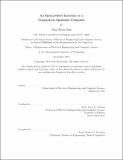An optical-fiber interface to a trapped-ion quantum computer
Author(s)
Kim, Tony Hyun
DownloadFull printable version (16.28Mb)
Other Contributors
Massachusetts Institute of Technology. Dept. of Electrical Engineering and Computer Science.
Advisor
Isaac L. Chuang.
Terms of use
Metadata
Show full item recordAbstract
The trapped-ion quantum computer is an atom-based implementation of a quantum computer that has successfully demonstrated numerous quantum algorithms and the potential for scalability. Fundamental to its operation is the short-range Coulombic interaction among its atomic ion registers, which has led to the development of local, single-chip devices. In this work, we demonstrate the integration of an optical-fiber with a planar ion trap, and show the physical interaction between fiber light and the trapped-ion qubit. As the single-mode fiber is well-suited to the transport of single photons, the fiber interface (when augmented by an optical cavity) represents a means to link distantly located quantum computers through a common optical network. Hence, this work represents a step towards the paradigm of distributed quantum computing: self-contained, technically-simple processors may be optically linked together to perform large-scale quantum computation. This thesis is divided into two parts. In the first, we provide a thorough review of ion trap design and a detailed numerical analysis of trapped-ion motion. This theoretical discussion culminates with the development of an electronic technique that permits the arbitrary, in situ positioning of a trapped atom in the ion trap. The positioning ability is an enabling technology for trap-integration as it allows for complete freedom in the alignment of the trapped atom with respect to the integrated element. In the second part, the construction of the experimental setup and the integrated "fibertrap" is described. In our experiment, a single 38Sr+ is trapped 670 [mu]m above the end of an optical fiber in a cryogenic (8 K) surface-electrode ion trap. The fiber serves as an integrated source of laser light, which drives the quadrupole qubit transition of 88Sr+. Using in situ translation of the ion, the Gaussian beam profile of the fiber output is imaged, and the fiberion displacement, in units of the mode waist at the ion, is optimized to within 0.13 ± 0.10 of the mode center despite an initial offset of 3.30 ± 0.10 arising from fabrication. We also quantify the perturbative effects of the fiber dielectric on ion trap operation. Light-induced charging by 125 [mu]W of 674 nm fiber light is measured as an induced electric field of ~ 10 V/m at the ion, with charging and discharging time constants of 1.6 ± 0.3 s and 4.7 t 0.6 s. These measurements are of general importance to trapped-ion quantum computing, where the scalability of the platform depends crucially on the feasibility of on-chip optics integration.
Description
Thesis (M. Eng.)--Massachusetts Institute of Technology, Dept. of Electrical Engineering and Computer Science, 2011. This electronic version was submitted by the student author. The certified thesis is available in the Institute Archives and Special Collections. Cataloged from PDF version of thesis. Includes bibliographical references (p. 163-174).
Date issued
2011Department
Massachusetts Institute of Technology. Department of Electrical Engineering and Computer SciencePublisher
Massachusetts Institute of Technology
Keywords
Electrical Engineering and Computer Science.